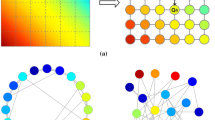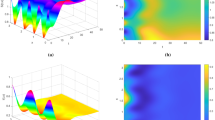Abstract
This paper reports some qualitative results of a diffusive rumor propagation model with homogeneous no-flux boundary conditions. Firstly, the permanence is exhibited of the spatiotemporal rumor model. Then the boundedness of solutions, the nonexistence and existence of the non-constant steady states of the spatial rumor propagation model are explored. It is shown that the non-constant steady states may exist when the migration rate of the rumor-infected individuals is fixed and the migration rate of the rumor-susceptible individuals is large. By contrast, there are no non-constant steady states as the migration rates of the rumor-susceptible individuals and the rumor-infected individuals are fixed and large, respectively. These qualitative investigation results enhance the theoretical study of the spatial propagation rumor model.





Similar content being viewed by others
Data availability
All data generated or analysed during this study are included in this published article or available upon request.
References
Daley, D.J., Kendall, D.G.: Epidemics and rumours. Nature 204, 1118 (1964)
Daley, D.J., Kendall, D.G.: Stochastic rumours. IMA J. Appl. Math. 1, 42–55 (1965)
Zanette, D.: Critical behavior of propagation on small-world networks. Phys. Rev. E 64, 050901 (2001)
Dong, S., Deng, Y.B., Huang, Y.C.: SEIR model of rumor spreading in online social network with varying total population size. Commun. Theor. Phys. 68, 545 (2017)
Zan, Y.L.: DSIR double-rumors spreading model in complex networks. Chaos Solitons Fractals 110, 191–202 (2018)
Zhao, H.Y., Zhu, L.H.: Dynamic analysis of a reaction-diffusion rumor propagation model. Int. J. Bifurc. Chaos 26, 1650101 (2016)
Huo, L.A., Jiang, J.H., Gong, S.X., et al.: Dynamical behavior of a rumor transmission model with Holling-type II functional response in emergency event. Physica A 450, 228–240 (2016)
Li, K.Z., Zhu, G.H., Ma, Z.J., et al.: Dynamic stability of an SIQS epidemic network and its optimal control. Commun. Nonlinear Sci. Numer. Simul. 66, 84–95 (2019)
Wu, H., Zhang, Z.J., Fang, Y.B.: Containment of rumor spread by selecting immune nodes in social networks. Math. Biosci. Eng. 18, 2614–2631 (2021)
Piqueira, J.R.: Rumor propagation model: an equilibrium study. Math. Probl. Eng. 2020, 631357 (2020)
Singh, J.: A new analysis for fractional rumor spreading dynamical model in a social network with Mittag–Leffler law. Chaos 29, 013137 (2019)
Chen, W.K., Zhang, H., Georgescu, P., et al.: Taming obstinate spreaders: the dynamics of a rumor spreading model incorporating inhibiting mechanisms and attitude adjustment. Comput. Appl. Math. 40, 125 (2021)
Musa, S., Fori, M.: Mathematical model of the dynamics of rumor propagation. J. Appl. Math. Phys. 7, 1289–1303 (2019)
Li, J.R., Jiang, H.J., Yu, Z.Y., et al.: Dynamical analysis of rumor spreading model in homogeneous complex networks. Appl. Math. Comput. 359, 374–385 (2019)
Wang, J.L., Jiang, H.J., Hu, C., et al.: Stability and Hopf bifurcation analysis of multi-lingual rumor spreading model with nonlinear inhibition mechanism. Chaos Solitons Fractals 153, 111464 (2021)
Zhu, L.H., Huang, X.Y., Liu, Y., Zhang, Z.D.: Spatiotemporal dynamics analysis and optimal control method for an SI reaction-diffusion propagation model. J. Math. Anal. Appl. 493, 124539 (2021)
Lou, Y., Ni, W.M.: Diffusion, self-diffusion and cross-diffusion. J. Differ. Equ. 131, 79–131 (1996)
Chen, M.X., Wu, R.C., Xu, Y.C.: Dynamics of a depletion-type Gierer–Meinhardt model with Langmuir–Hinshelwood reaction scheme. Discrete Contin. Dyn. Syst. B 27, 2275–2312 (2022)
Chen, M.X., Wu, R.C.: Dynamics of diffusive nutrient-microorganism model with spatially heterogeneous environment. J. Math. Anal. Appl. 511, 126078 (2022)
Zhou, J., Shi, J.P.: Pattern formation in a general glycolysis reaction-diffusion system. IMA J. Appl. Math. 80, 1703–1738 (2015)
Cai, Y.L., Zhao, C.D., Wang, W.M.: Spatiotemporal complexity of a Leslie–Gower predator–prey model with the weak Allee effect. J. Appl. Math. 2013, 535746 (2013)
Ghergu, M.: Non-constant steady-state solutions for Brusselator type systems. Nonlinearity 21, 2331–2345 (2008)
Liu, G.D., Chang, Z.B., Meng, X.Z., et al.: Optimality for a diffusive predator–prey system in a spatially heterogeneous environment incorporating a prey refuge. Appl. Math. Comput. 384, 125385 (2020)
Shi, H.B., Li, W.T., Lin, G.: Positive steady states of a diffusive predator–prey system with modified Holling–Tanner functional response,. Nonlinear Anal.: RWA 11, 3711–3721 (2010)
Chen, M.X., Wu, R.C., Wang, X.H.: Non-constant steady states and Hopf bifurcation of a species interaction model. Commun. Nonlinear Sci. Numer. Simul. 116, 106846 (2023)
Pang, Y.H.P., Wang, M.X.: Non-constant positive steady states of a predator-prey system with non-monotonic functional response and diffusion. Proc. Lond. Math. Soc. 1, 135–157 (2004)
Acknowledgements
This work was supported by the National Natural Science Foundation of China (Nos. 11971032, 12002297), and funded by China Postdoctoral Science Foundation (No. 2021M701118).
Author information
Authors and Affiliations
Contributions
Mengxin Chen: Formal analysis, Writing-original draft, Review & editing; Ranchao Wu: Supervision, Methodology, Revision; Qianqian Zheng: Software, Review & editing.
Corresponding author
Ethics declarations
Conflict of interest
The authors declare no conflict of interest.
Additional information
Publisher's Note
Springer Nature remains neutral with regard to jurisdictional claims in published maps and institutional affiliations.
Rights and permissions
Springer Nature or its licensor (e.g. a society or other partner) holds exclusive rights to this article under a publishing agreement with the author(s) or other rightsholder(s); author self-archiving of the accepted manuscript version of this article is solely governed by the terms of such publishing agreement and applicable law.
About this article
Cite this article
Chen, M., Wu, R. & Zheng, Q. Nonconstant Steady States of a Rumor Propagation Model. Differ Equ Dyn Syst (2023). https://doi.org/10.1007/s12591-023-00641-2
Accepted:
Published:
DOI: https://doi.org/10.1007/s12591-023-00641-2




